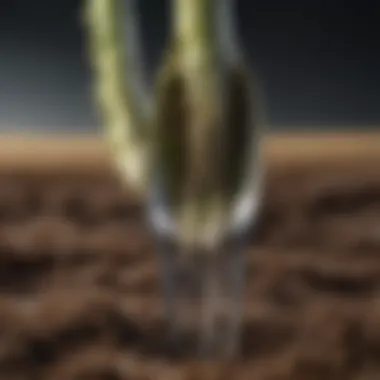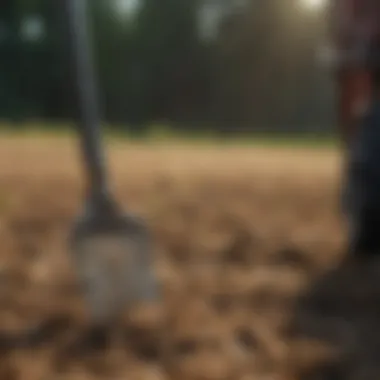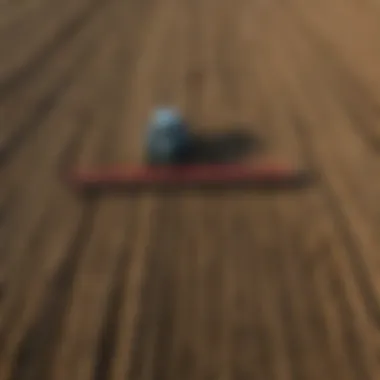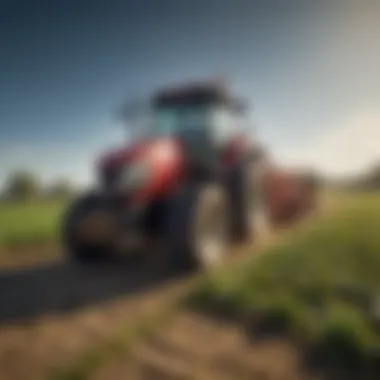The Essential Role of Ensilage Forks in Agriculture


Intro
The ensilage fork is a fundamental tool in modern agriculture, particularly vital in the management of silage. Its design has evolved significantly to meet the demands of efficiency and sustainability. Understanding its functionality and historical context allows us to appreciate its impact on farming practices. This article aims to delve into the various aspects of the ensilage fork, providing a comprehensive overview while also emphasizing its role in contemporary fodder management.
Topic Overview
Definition and Importance
An ensilage fork is a specialized tool used primarily for handling silage. It facilitates the transfer of forage crops that have been fermented and stored in a silage structure. The fork has tines that allow farmers to lift and distribute silage with ease, maintaining the integrity of the crop while minimizing waste. Its importance cannot be overstated, as effective silage management is critical for livestock nutrition and productivity.
Brief History and Evolution
The origins of the ensilage fork can be traced back to traditional farming methods, which relied on manual labor. As agricultural practices advanced, the design of the ensilage fork also evolved. Early versions were often heavy and cumbersome, lacking ergonomic considerations. However, contemporary models feature lightweight materials and refined designs to enhance usability. The evolution of this tool reflects broader changes in agricultural technology, aiming for increased efficiency and reduced labor.
Key Techniques and Innovations
Sustainable Farming Practices
The ensilage fork plays a crucial role in sustainable farming. Its design allows for efficient handling of silage, which is essential for preserving nutrients in forage crops. Sustainable practices focus on minimizing waste and enhancing resource use. Farmers utilizing the ensilage fork can ensure that more of their feed resources are effectively utilized, contributing to overall productivity and sustainability in farming.
Advanced Agronomic Technologies
Recent advancements in agronomic technologies have influenced the design of the ensilage fork. Innovations such as improved materials and auditory feedback for better load handling are now commonplace. These enhancements aid farmers in managing their silage more efficiently. Additionally, technology integration in farming equipment continues to grow, facilitating better data collection and resource management.
Practical Applications
Step-by-Step Guides
- Selecting the Right Fork: Choose a fork suited for the type of silage and the volume you manage.
- Proper Techniques: Use a scooping motion to minimize silage loss and ensure uniform distribution.
- Maintenance: Regularly inspect the fork for wear and tear. Cleaning it after use preserves its functionality.
Case Studies or Real-World Examples
In a recent case study conducted in Iowa, a local farm implemented the ensilage fork to improve their silage handling. Over a season, the farm reported a 15% decrease in waste, leading to improved feed efficiency. Such examples underscore the practical benefits and relevance of the ensilage fork in today’s farming landscape.
"Efficiency in fodder management is not just about tools; it is about how those tools integrate into a holistic farming approach."
Overall, the ensilage fork stands as a testament to how traditional farming tools can evolve while remaining integral to modern agricultural practices. By incorporating advanced techniques and sustainable practices, farmers can enhance their productivity and contribute to a more sustainable agricultural future.
Intro to the Ensilage Fork
The ensilage fork plays a crucial role in silage management, a key aspect of modern agriculture. Understanding this tool is essential for farmers and agricultural enthusiasts alike. This section will explore its definition, purpose, and historical significance. The ensilage fork aids in the efficient handling of silage, which is vital for maintaining the nutritional value of fodder for livestock.
Definition and Purpose
An ensilage fork is a specialized tool used primarily for handling silage. Its design allows for effective loading, unloading, and transferring of silage from storage structures to feeding areas. The fork’s tines penetrate the silage mass, helping to lift and transport it without causing excessive spoilage. The main purpose of the ensilage fork is to facilitate the easy movement of silage, ensuring that livestock have constant access to high-quality fodder.
Historical Development
Early Agricultural Tools
In the early days of agriculture, tools were basic yet effective for their time. Tools like pitchforks were commonly employed, which had simple designs and were primarily made from wood or metal. These implements contributed significantly to early farming practices. Their ability to lift and transport bulk materials made them essential in the management of fodder. However, traditional pitchforks could struggle with denser silage, thereby limiting efficiency.
The key characteristic of early agricultural tools lies in their simplistic design. This simplicity allowed for easy repair and maintenance, making them a popular choice among farmers. The downside, however, was a lack of efficiency in handling modern silage, which is more compact and dense than grasses or grains used in earlier times.
Transition to Modern Design
The transition to modern ensilage fork design marked a significant advancement in agricultural practices. Innovations introduced stronger materials and ergonomic shapes that enhance usability. Today's ensilage forks often combine metallic and composite materials, resulting in products that are not only lightweight but also durable and effective against wear and tear.
The characteristic feature of modern ensilage forks is their specialized tines, which are designed to minimize damage to silage while optimizing lifting capability. This transformation has made the ensilage fork a beneficial choice for farmers looking to maximize efficiency and preserve feed quality. However, the introduction of advanced materials can also lead to higher costs, posing a disadvantage for smaller operations or those with limited budgets.
Through understanding the history and evolution of the ensilage fork, farmers can better appreciate its role in enhancing silage management practices today.


Design Characteristics of the Ensilage Fork
The design characteristics of the ensilage fork play a critical role in its effectiveness and functionality. Understanding these elements helps farmers and agricultural enthusiasts appreciate the tool's innovative features. An effective ensilage fork combines material selection and geometrical design to optimize performance in various tasks involved in silage management. This section will explore the specific materials used in production, as well as the variations in size and shape that contribute to efficiency.
Materials Used
Metallic vs. Composite Materials
The choice of materials is central to the ensilage fork’s design. Traditionally, metallic materials such as steel or aluminum have been the go-to option for their inherent strength. Metal forks usually offer high durability under intense conditions, making them reliable for heavy-duty tasks. However, the weight of stainless steel can be a drawback, as it may hinder maneuverability in certain situations.
In contrast, composite materials have emerged in modern designs. They often consist of reinforced plastics or carbon fiber, which provide better weight management. Composite forks are lighter and generally resistant to corrosion, leading to reduced maintenance needs. However, there is a trade-off in tensile strength compared to metal, which can affect the fork’s performance under extreme loads.
Impact on Durability
Durability is a crucial aspect when considering an ensilage fork. The impact on durability is determined by material choices and how these materials withstand harsh conditions. Both metallic and composite forks have their distinct advantages. Metal forks tend to excel in terms of long-term robustness, as they can endure significant wear and tear. Yet, they may require more frequent maintenance due to rust and other environmental factors.
On the other hand, composite materials enhance durability in a different sense. They are often less susceptible to damage from moisture and other corrosive elements. The unique feature here is that composite forks can maintain their structural integrity over time, with fewer issues compared to metallic options. However, the initial cost might be higher, raising considerations about cost-effectiveness in the long run.
Size and Shape Variations
Standard Sizes
The standard sizes of ensilage forks have become industry benchmarks. These sizes are designed based on common agricultural needs, allowing farmers to select the right tools efficiently. Standard forks typically cater to average load sizes, ensuring compatibility with most silage management processes.
A key characteristic of standard sizes is their versatility. With widely accepted dimensions, these forks are readily available and generally cost-effective. Farmers can easily find replacement parts or make repairs without significant disruption to their operations. However, the downside may be that standard sizes can limit specific practices for farmers with niche requirements.
Custom Designs
The concept of custom designs presents an exciting alternative for precision in agricultural tasks. Customized ensilage forks can be tailored to fit unique operational requirements. This option is especially beneficial for farmers who manage distinct types of fodder or have particular silage practices.
One major benefit of custom designs is their optimized efficiency. By tailoring the fork's dimensions or construction material, farmers can increase their productivity significantly. However, it is important to consider the potential challenges. Custom tools may require longer lead times for production and can be more expensive than off-the-shelf options, posing budgetary concerns.
Functionality and Operational Techniques
The functionality and operational techniques associated with the ensilage fork significantly shape its effectiveness in modern agriculture. Understanding how to efficiently load and unload silage, as well as choosing the right fork for specific tasks, enhances productivity while ensuring optimal management of fodder resources. This section examines these key aspects in a practical context, emphasizing their relevance to farmers and agricultural enthusiasts alike.
Loading and Unloading
The process of loading and unloading silage is central to the use of ensilage forks in farming operations. A proper technique not only minimizes spoilage but also reduces handling time, leading to greater efficiency in feeding operations. When loading silage, it is important to use the fork’s tines effectively to maximize the amount picked up. The angle of approach matters; tilting the fork slightly can help to scoop more material without damaging the silage. When unloading, accuracy is vital. Farmers should ensure proper placement of silage to prevent waste and enhance access for livestock.
In addition, strategically timing the loading and unloading processes can lead to better silage preservation. For example, loading during cooler parts of the day can help to reduce losses that occur due to exposure to heat. Implementing these operational techniques improves both the qualitative and quantitative aspects of silage management.
Choosing the Right Fork
Selecting the appropriate ensilage fork is crucial for effective silage handling. Various factors influence this decision, including design specifications and the intended usage. Here are some essential considerations:
Factors to Consider
Durability and Material Composition: One key characteristic is the construction material of the ensilage fork. Options range from galvanized steel to lightweight composite materials. These choices bear consequences for durability and ease of use. Galvanized steel, although heavier, often provides sturdiness ideal for rough conditions, making it a favorable choice for many farmers. On the other hand, composite materials may offer benefits such as reduced weight, which can improve maneuverability and decrease user fatigue.
Size Matters: The fork’s dimensions also play a vital role. Standard sizes may suffice for many farmers, but those handling larger volumes of silage might find custom designs more beneficial. The size should align with both the capacity of feeding equipment and the specific needs of the operation.
Common Mistakes
One common mistake made by farmers is underestimating the importance of selecting a fork that fits the specific task. Not considering the type of silage being handled or the operational methods can lead to inefficiencies. For instance, some may opt for a lighter fork for the sake of convenience but later find that it lacks the strength for denser materials.
Another frequent oversight is failing to conduct routine maintenance on the fork. Neglecting maintenance can result in wear and tear that compromises performance. Regularly checking for damage, rust, or bending can ensure longevity and reliability of the tool.
"Proper maintenance not only extends the life of the ensilage fork but also ensures optimal operational efficiency."
Impact on Silage Management
The ensilage fork plays a crucial role in managing silage, which is vital for livestock nutrition. Proper handling of silage can influence overall farm productivity. Using an ensilage fork effectively contributes to several important aspects of silage management, allowing for improved efficiency and quality.


Efficiency in Feeding Operations
Time Savings
One of the main advantages of using an ensilage fork is time savings. When farmers and workers use this tool, they can load and unload silage at a much faster rate than traditional methods. Fast operations are necessary in peak seasons, such as harvest time, where every minute counts. Efficient use of the fork reduces downtime, allowing for more significant productivity.
A key characteristic of time savings is its impact on overall farm management. If feeding operations can be sped up, farms can reduce costs, leading to better financial performance. A unique feature of time savings is that it enhances the coordination between farm operations, making it easier to manage tasks.
Labor Reduction
Labor reduction is another important aspect linked to the enisilage fork. When using this tool, fewer workers may be needed to perform feeding operations, which can help address labor shortages faced by many farms today. By automating some of the physical tasks through better tools, it is possible to achieve similar results with less manpower.
The key characteristic of labor reduction lies in its cost effectiveness. Farms can reallocate labor to other areas, improving overall operational efficiency. A downside may be the initial investment in quality ensilage forks, but the long-term savings in labor costs often justify this expense.
Quality Preservation of Silage
Minimizing Spoilage
Minimizing spoilage is essential for maintaining the quality of silage. An ensilage fork allows for careful handling, reducing the amount of damage to the silage during transportation. Damage can lead to mushroom growth or fermentation problems, which compromise the quality of silage and ultimately affect livestock health.
The key characteristic here is that effective management can increase the nutritional value of delivered silage. Implementing proper handling techniques translates into better feed for animals, which is a significant benefit for farmers. A unique feature is the precision offered by modern ensilage forks, which can prevent unnecessary losses brought by spoilage.
Optimal Packing Techniques
Optimal packing techniques are crucial for maintaining silage quality. An ensilage fork can provide better packing efficiency compared to older approaches. When silage is packed well, it limits air exposure and preserves nutrients, vital for healthy animal feeding.
The key characteristic of optimal packing techniques directly relates to the potential for improved feed efficiency. If the silage is stored properly, it can keep its nutrition values much longer. This leads to less waste on the farm and improves the economic value of operations. A unique feature stems from various design aspects of modern ensilage forks, which can adapt to different silage types and packing needs efficiently.
Proper management of silage with the help of an ensilage fork is not just about feeding; it is about ensuring the overall health and productivity of livestock.
Throughout all these considerations, it is evident that the ensilage fork significantly impacts silage management. The efficient feeding operations and quality preservation directly contribute to better farm sustainability and the long-term health of livestock.
Role in Sustainable Agriculture
Sustainable agriculture focuses on meeting the needs of the present without compromising the ability of future generations to meet their own needs. The ensilage fork plays a significant role in this aspect, particularly in how it interacts with various farming practices, contributing to both environmental and economic sustainability.
Environmental Considerations
Reducing Waste
Reducing waste is a critical component of sustainable practices. The ensilage fork minimizes wasted fodder during storage and feeding. By efficiently transporting silage, it prevents over-collection and subsequent spoilage, both of which contribute to unnecessary waste on farms.
The effectiveness of this tool is evident in its design, which allows for selective harvesting. This ability enables farmers to retain higher-quality silage and reduce losses, thus making it a beneficial choice for sustainable agriculture. The distinct feature of waste reduction is its impact on overall farm productivity as it allows resources to be maximized rather than discarded.
Contributing to Biodiversity
An important aspect of sustainable farming is maintaining biodiversity. The ensilage fork indirectly supports biodiversity by enabling better use of various crops. By providing farmers with the ability to harvest different types of silage with ease, they can engage in crop rotation and diversification.
This characteristic promotes a diverse ecosystem, which is essential for soil health and resilience. Moreover, with a well-maintained ecosystem, pests and diseases are often kept in check naturally, reducing the need for chemical interventions. Contributing to biodiversity through better fodder management ensures ecological balance, making it a celebrated choice in the sector.
Integration with Other Tools
Combining with Tractors
The ensilage fork's compatibility with tractors is crucial for modern farming operations. This integration maximizes productivity as it allows for swift collection and distribution of silage, thereby saving time and labor. By attaching the fork to tractors, farmers can leverage the machine's power to handle heavier loads, making the task of transporting silage much easier.
The synergy between these tools enhances operational efficiency, leading to better resource use. However, it is essential to ensure that the connections and mechanisms are well-maintained to prevent wear and tear over time.
Interplay with Other Handling Equipment
The ensilage fork functions effectively alongside other handling equipment like loaders and conveyors. This interplay creates a comprehensive system for silage management, where each tool complements the others in function. For example, using the fork with a loader can streamline the process of moving silage from storage to feeding areas.
The unique aspect of this integration lies in its ability to create a seamless workflow. However, coordinating these tools requires careful planning and training, as poor usage can lead to inefficiencies or equipment damage.


Maintenance and Care
The efficient operation of an ensilage fork requires consistent attention to maintenance and care. Regular upkeep not only prolongs the life of the tool but also ensures it functions optimally during critical silage management tasks. When farmers invest time in maintenance, they minimize costs associated with repairs and replacements. Furthermore, well-maintained equipment contributes to safer work environments and enhances overall productivity.
Routine Maintenance Practices
Routine maintenance practices are essential for preserving the integrity of the ensilage fork. This includes:
- Cleaning: After each use, it is important to clean the ensilage fork to remove any residual silage and dirt. This debris can cause corrosion over time if left unattended.
- Lubrication: Regular lubrication of moving parts is crucial. This helps prevent friction-related wear, ensuring smoother operation.
- Inspection: Frequent checks for any signs of damage or wear should be conducted. This proactive step can identify problems before they lead to equipment failure.
By adhering to these basic practices, farmers can ensure their tools remain reliable and efficient throughout their life cycle.
Troubleshooting Common Issues
Common issues may arise even with diligent maintenance. Identifying these problems early can help avoid significant setbacks in silage management. Here, we will discuss two key topics: identifying wear and tear, and repair techniques.
Identifying Wear and Tear
Identifying wear and tear is critical for maintaining operational efficiency. Common indicators include:
- Cracks or bends in the tines
- Rust formation on metal components
- Loose connections between parts
Recognizing these signs is vital as they directly impact the fork's performance. Immediate attention to wear issues can prevent further damage and prolonged downtimes. Regular inspections should focus on these aspects and facilitate timely interventions.
Repair Techniques
When issues are located, applying effective repair techniques is necessary to restore functionality. Common repair practices include:
- Welding: For cracks in metal parts, welding offers a durable solution.
- Replacements: Sometimes individual components may need to be replaced entirely, especially if they show extensive wear.
Utilizing the right repair techniques ensures the ensilage fork continues to serve its purpose effectively. Quick repairs can lead to minimized downtime, maintaining the efficiency of lot management.
Proper maintenance and timely repairs are cornerstones of effective silage management. These practices safeguard investment and ensure consistent performance.
In summary, embracing a culture of maintenance and care for ensilage forks not only safeguards the equipment itself but also contributes to the overall efficiency and effectiveness of agricultural operations. Farmers who prioritize proper care can expect better productivity and performance from their essential tools.
Future Innovations in Ensilage Fork Design
In the ever-evolving landscape of agriculture, future innovations in ensilage fork design play a crucial role in enhancing functionality and efficiency. As the demands on farming continue to grow, so does the need for tools that can adapt and innovate. This section will explore the advancements in technology and shifts in agricultural practices that are shaping the future of the ensilage fork.
Technological Advancements
Smart Farming Integration
Smart farming integration represents a significant leap in agricultural technology. This approach involves utilizing advanced technologies such as automation and data analytics. It allows for a more precise and efficient way to manage farming activities. The key characteristic of smart farming integration is its ability to collect and analyze data in real time. This data-driven decision-making approach is increasingly favored in modern agriculture.
One unique feature of smart farming integration is its use of GPS technology. Farmers can target specific areas in their fields, ensuring that the use of resources is optimal. However, while the integration of smart farming yields improved efficiency, it can also require substantial initial investments in technology and training, which may pose challenges for smaller operations.
Sensor Technology
Sensor technology represents another cutting-edge development in the agricultural sector. These sensors can monitor various parameters such as moisture levels, temperature, and even the condition of the crop. The main advantage of using sensors is their ability to provide immediate feedback. This enables farmers to adapt their strategies based on real-time information.
A distinctive feature of sensor technology is its ability to integrate with existing equipment, including ensilage forks. By enhancing traditional tools with sensor capabilities, farmers can improve their operational efficiencies. However, the reliance on technology can create dependency, where a failure in sensor functionality may disrupt operations.
Trends in Agricultural Practices
Sustainability Focus
The sustainability focus in agriculture is increasingly driving innovation and design. Emphasizing practices that promote environmental stewardship resonates strongly with consumers and farmers alike. A notable characteristic of the sustainability focus is its incorporation of eco-friendly materials and methods. This aspect is beneficial as it helps reduce the carbon footprint associated with farming.
A unique feature of sustainability-focused practices is their integrative approach. Systems often combine various elements such as crop rotation and reduced use of pesticides. While sustainability practices are advantageous, the transition can be complex and may require changes in traditional farming methods that some farmers might resist.
Regenerative Agriculture Techniques
Regenerative agriculture techniques emphasize restoring soil health and ecosystem balance. This approach goes beyond mere sustainability; it seeks to improve and renew resources. The key characteristic of regenerative techniques is their long-term focus on building soil carbon and enhancing biodiversity.
This method offers unique advantages, including improved resilience against pests and adverse weather conditions. However, evolving into regenerative practices can require a significant shift in farming mindset and operation. Not every farmer may find these techniques immediately applicable or beneficial, given their conventional methods.
Future advancements in ensilage fork design will be intertwined with technological and sustainable practices, ultimately shaping the future of agricultural efficiency.



